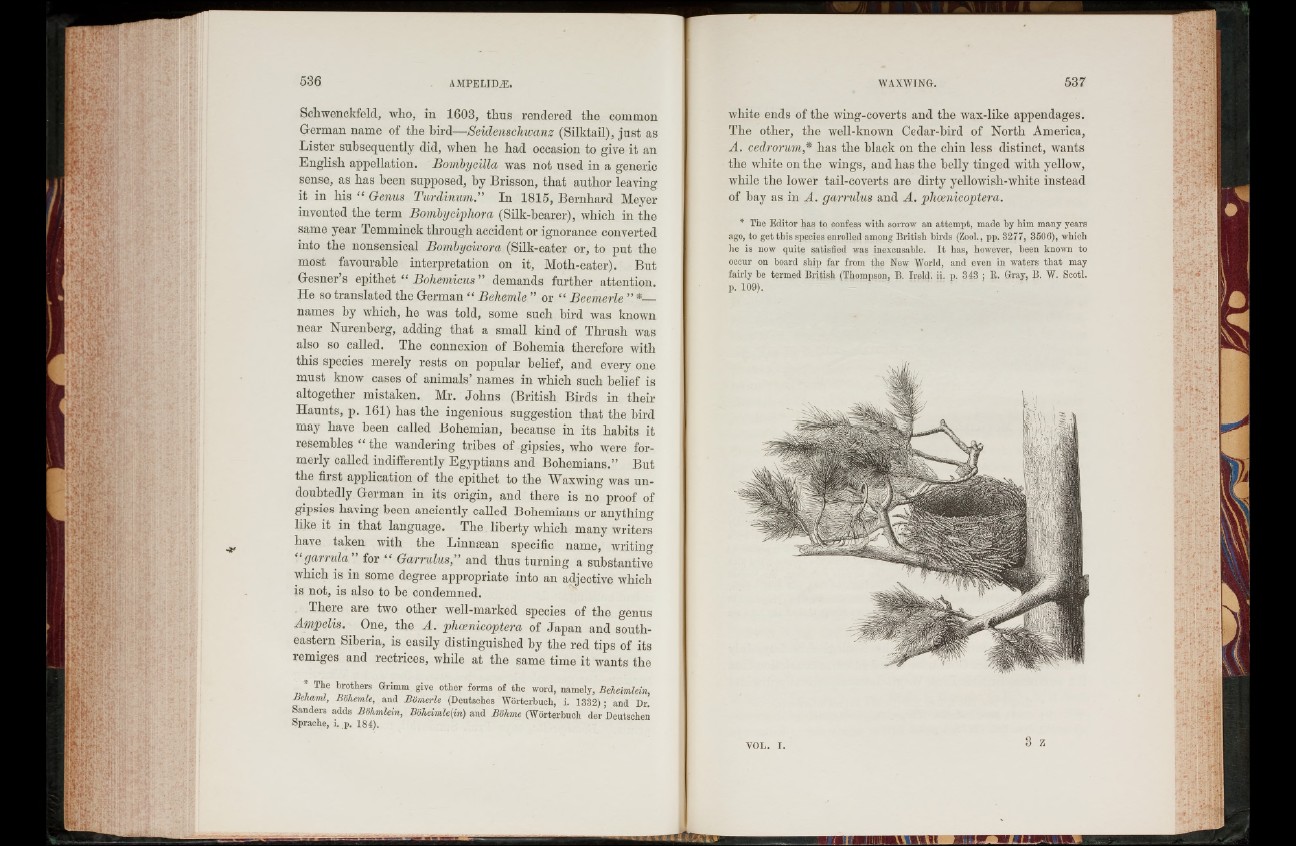
Schwenckfeld, who, in 1603, thus rendered the common
German name of the bird—-Seidenschwanz (Silktail), just as
Lister subsequently did, when he had occasion to give it an
English appellation. Bombycilla was not used in a generic
sense, as has been supposed, by Brisson, that author leaving
it in his “ Genus T u r d i n u m In 1815, Bernhard Meyer
invented the term Bombycipliora (Silk-bearer), which in the
same year Temminck through accident or ignorance converted
into the nonsensical Bombycivora (Silk-eater or, to put the
most favourable interpretation on it, Moth-eater). But
Gesner’s epithet “ Bohemicus ” demands further attention.
He so translated the German “ Behemle ” or “ Beemerle ” *__
names by which, he was told, some such bird was known
near Nurenberg, adding that a small kind of Thrush was
also so called. The connexion of Bohemia therefore with
this species merely rests on popular belief, and every one
must know cases of animals’ names in which such belief is
altogether mistaken. Mr. Johns (British Birds in their
Haunts, p. 161) has the ingenious suggestion that the bird
may have been called Bohemian, because in its habits it
resembles “ the wandering tribes of gipsies, who were formerly
called indifferently Egyptians and Bohemians.” But
the first application of the epithet to the Waxwing was undoubtedly
German in its origin, and there is no proof of
gipsies having been anciently called Bohemians or anything
like it in that language. The liberty which many writers
have taken with the Linnaean specific name, writing
“ garrula” for “ Garrulus,” and thus turning a substantive
which is in some degree appropriate into an adjective which
is not, is also to be condemned.
There are two other well-marked species of the genus
Ampclis. One, the A . phcenicoptera of Japan and southeastern
Siberia, is easily distinguished by the red tips of its
remiges and rectrices, while at the same time it wants the
* The brothers Grimm give other forms of the word, namely, Beheimlein,
Behaml, Böhemle, and Bömerle (Deutsches Wörterbuch, i. 1332); and Dr!
Sanders adds Böhmlein, Böheimle(in) and Böhme (Wörterbuch der Deutschen
Sprache, i. p. 184).
white ends of the wing-coverts and the wax-like appendages.
The other, the well-known Cedar-bird of North America,
A. cedrorum,* has the black on the chin less distinct, wants
the white on the wings, and lias the belly tinged with yellow,
while the lower tail-coverts are dirty yellowisli-white instead
of bay as in A. garrulus and A. phcenicoptera.
* The Editor has to confess with sorrow an attempt, made by him many years
ago, to get this species enrolled among British birds (Zool., pp. 3277, 3506), which
he is now quite satisfied was inexcusable. I t has, however, been known to
occur on board ship far from the New World, and even in waters that may
fairly be termed British (Thompson, B. Ireld. ii. p. 343 ; K. Gray, B. W. Scotl.
p. 109).
VOL. I .